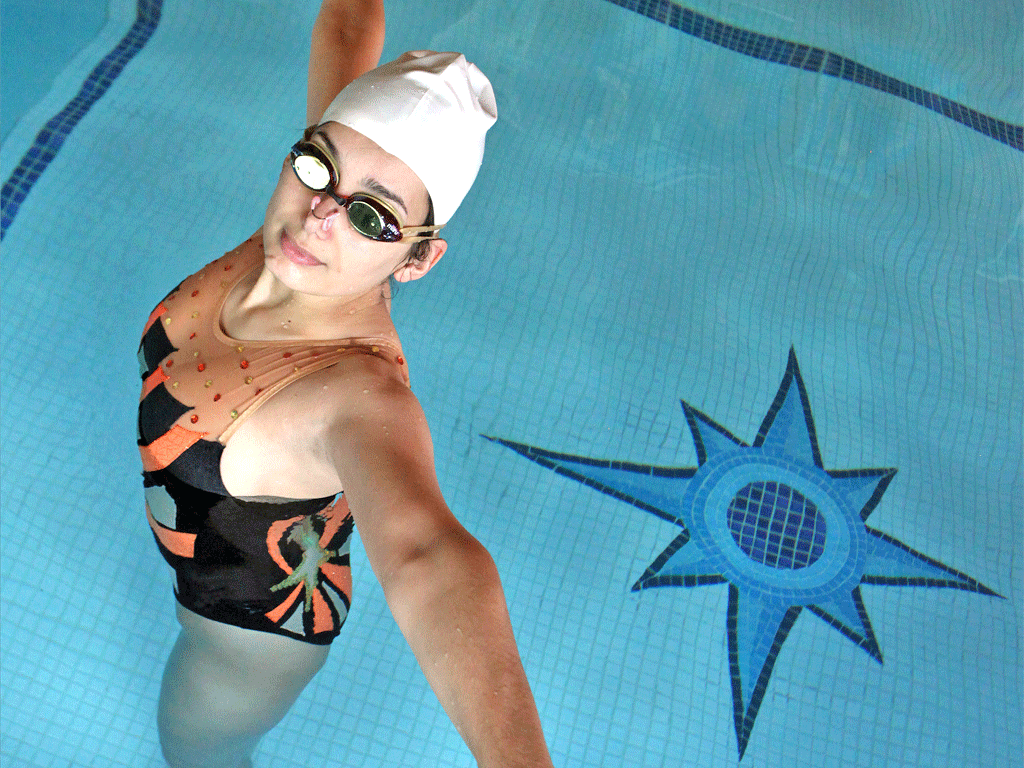In at the deep end: An afternoon with Team GB's synchronised swimmers
As the synchro team event begins, Rebecca Gonsalves dons goggles and nose clip – and takes the plunge

As a spectator, the Olympic disciplines which have long been the most fascinating are those which appear to be executed without effort – no matter how much logic, and gravity, would attest to the contrary. The obvious grist that accompanies a sprint or long-distance run leaves me feeling spent just watching from the sofa, while the elegance of contracting muscles and swinging limbs of the more balletic sports is somehow energising (rictus grins aside).
Synchronised swimming then, appears to offer the best, or perhaps worst, of both worlds. It may be unbelievably hard work, but the secret is not to show it to the judges or spectators – all while wearing a spangly costume, make-up that would make a drag queen's look subtle and, who could forget, an oh-so-glamorous nose clip.
On the eve of the first stage of the team finals, Louise Woolley, the 27-year-old development coach who trained current captain Jenna Randall and led the British team to the World Championships in 2009 is ready to put me through my paces in the pool at her parents' Beckenham home.
First, though, I must slip into a suitably glitzy creation and am handed a diamanté strewn orange and black velvet costume made by Woolley's mother for a previous performance. Luckily, I don't have to slick back my hair with a paste made from cooking gelatine and hot water (marks are deducted for hairs out of place) or paint my face with waterproof make-up. I haven't, however, escaped the nose clip, which Woolley hands to me (to stop water going into my sinuses when I'm upside down) along with a white swimming cap and a pair of goggles. By now, it's too late to back out.
Then the lesson begins. First comes a "back layout", a seemingly simple position where I must keep my body horizontal, floating on the surface. My legs must be held tightly together, toes pointed and chin pushed towards the ceiling.
Simple? Not exactly. Every time I look to check my toes are pointing in the right direction, my bottom starts to sink. Woolley is nothing if not a determined coach though, and after she helps me straighten out somewhat, I am told to bend one leg at the knee to achieve the "sailboat" position before straightening it in the air – toes pointed, of course – in what is known as "ballet leg". And, as my head repeatedly ducks under the water, I am beginning to feel very fond of that nose clip.
I then try to do handstands, both in the shallow end and in slightly deeper water, where I also attempt "sculls" – small hand movements which keep one buoyant when upside down underwater. From a handstand I kick my legs apart to achieve a split leg position. A gold medallist can perform this with their legs out of water down to the thigh. Woolley advises me to try to stick mine out a few inches above my ankles. Still I struggle.
Exhausted by the continual treading water, or "egg beating", we move on to "boosts". Here, I have to jump out of the water, propelling myself not against anything as solid as the floor of the pool but simply by straightening my bent arms and legs to achieve lift. The professionals can reach hip height – the high legs of their costumes enable the judges to see skin when performing these lifts, giving a sense of height as well as a lengthening effect on the competitors' legs.
Doing a no-frills boost isn't too hard (although I reach chest, rather than hip, height) but when Woolley encourages me to try it with my arms in a balletic pose and a smile plastered on my face it loses its gloss.
With that the lesson ends. As a soloist, I can't attempt the lifts and throws of team events and am left to rest panting on the poolside. It seems synchro is more than just spangly swimming costumes and winning smiles – it's about iron muscles and a will of steel.
Subscribe to Independent Premium to bookmark this article
Want to bookmark your favourite articles and stories to read or reference later? Start your Independent Premium subscription today.

Join our commenting forum
Join thought-provoking conversations, follow other Independent readers and see their replies